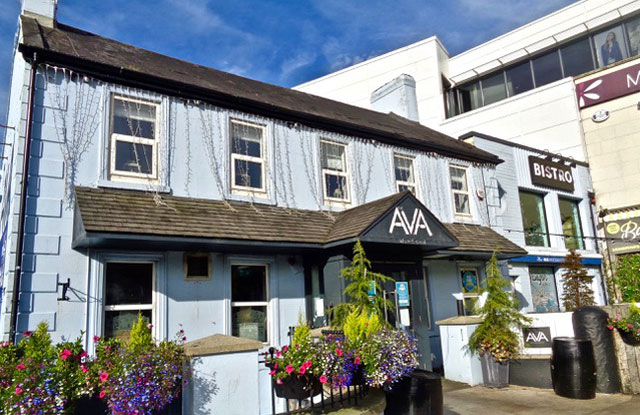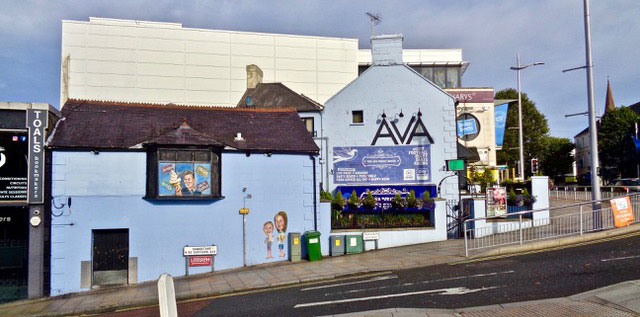The Ava stands at the junction of Main Street and Catherine Place*– now Dufferin Avenue. Patton dates its construction to about 1840 when it was built as a house by Doctor Russell who ran the dispensary in Catherine Place. Dr. Russell’s house became the Railway Hotel about 1870 and then reverted to being a private house. John Carroll opened the Ava Hotel there in 1892. The story of his attempt to get a spirit license for the premises is recorded in the North Down Herald and the Belfast NewsLetter. The reports reveal a good deal about matters such as the attitude to public houses in Bangor and the disorder caused by visitors to the town.

According to his lawyer Mr McCallum, John Carroll had superintended the building of the railway from Holywood to Bangor, which was completed in 1865. Then for some 25 years he had run refreshment rooms at the Railway Station, but in March 1891 the Railway Company gave him notice to quit. He now wished to apply for a spirit license for his new premises.
Even before the first hearing at Newtownards Quarter Sessions in late October 1891 there was opposition. A letter appeared in the North Down Herald on 9th October 1891. The writer was given as “Moderation” and argued that there were quite enough public houses in Bangor already and so the application should be refused. It designated the top of Catherine Place as a “most objectionable place” because of its nearness to the railway station. Moreover ladies and children found it an ugly corner as they passed to and from the station. The letter concludes that there was work here for social reformers and lovers of order and a memorial should be drawn up and submitted to the court which was to hear the application. The letter seems to be genuine and it reflects the feelings of the temperance lobby in the town.
Unfortunately at the first hearing things did not go smoothly for Mr Carroll. His lawyer argued that there was a need for licensed premises in that area of Bangor. Moreover the town had a summer population of 20,000 as opposed to a resident population of about 3,800. In addition two Bangor licenses had been lost when the esplanade had been redeveloped opposite the foot of High Street. One of these was held by Mrs O’Hara [see the article on the Steamboat Hotel] and the other by Samuel Mawhinney. Mr Carroll had already agreed to pay Mr John Henderson £270 for the premises. Mr McCallum also pointed out that the police had to attend the arrival and dispatch of all trains and so were regularly in the area. Extra police were in the town in the summer. Indeed he blamed any disturbances on those who arrived by steamboat at the other end of the town.
Mr Carroll’s license application was opposed by both the police and Bangor’s temperance lobby. District Inspector Winder referred to the trouble caused by travellers and the extra work another public house would create for the police. He did concede that there had been no complaints about Mr Carroll in the previous 25 years. Objections also came from the lawyer for the stationmaster, not surprisingly in view of his plans for new station refreshments.

Dr Keightly appeared on behalf of Samuel G Montgomery. The latter had drapery premises in Upper Main Street. Older residents may remember Simon’s shop on the same site. He argued that Bangor was “perfectly saturated with public houses” since there were no less than 18. In his evidence Mr Montgomery even argued that the number should be reduced. When the magistrates voted on the application 12 were against and 6 for it.
Mr Carroll applied again in January 1892. Similar arguments were used for and against and once more the application was refused. A third application was made in October 1892. Although it was opposed by James Bowman, the chairman of the Town Commissioners (as the local government of the day was known), as well as other local parishioners, it was finally granted by 13 votes to 6 and Mr Carroll could open his premises. On 29 October he advertised for an experienced barmaid for the premises at No 1 Catherine Place.
Early in 1893 a robbery took place at the hotel, when £54 went missing. A man living in West Street[now King’s Street] was arrested. He had been helping in the Ava bar. The police searched his house and garden. A sergeant found a tin canister in one of the neighbouring gardens which contained £31 in gold, £20 in notes and £2 17s 6d in silver. Other items were found in the robber’s house.
John Carroll died on 3 December 1898 and was buried in the family burying ground in Bangor Abbey graveyard. The Belfast NewsLetter carried a short report of his death. He had died at his residence, the Ava Hotel, at the age of almost eighty. The report noted that he “was extremely popular with all classes in Bangor”.
*in the nineteenth century the address was usually given as 1 Catherine Place; now it is 132 Main Street.
